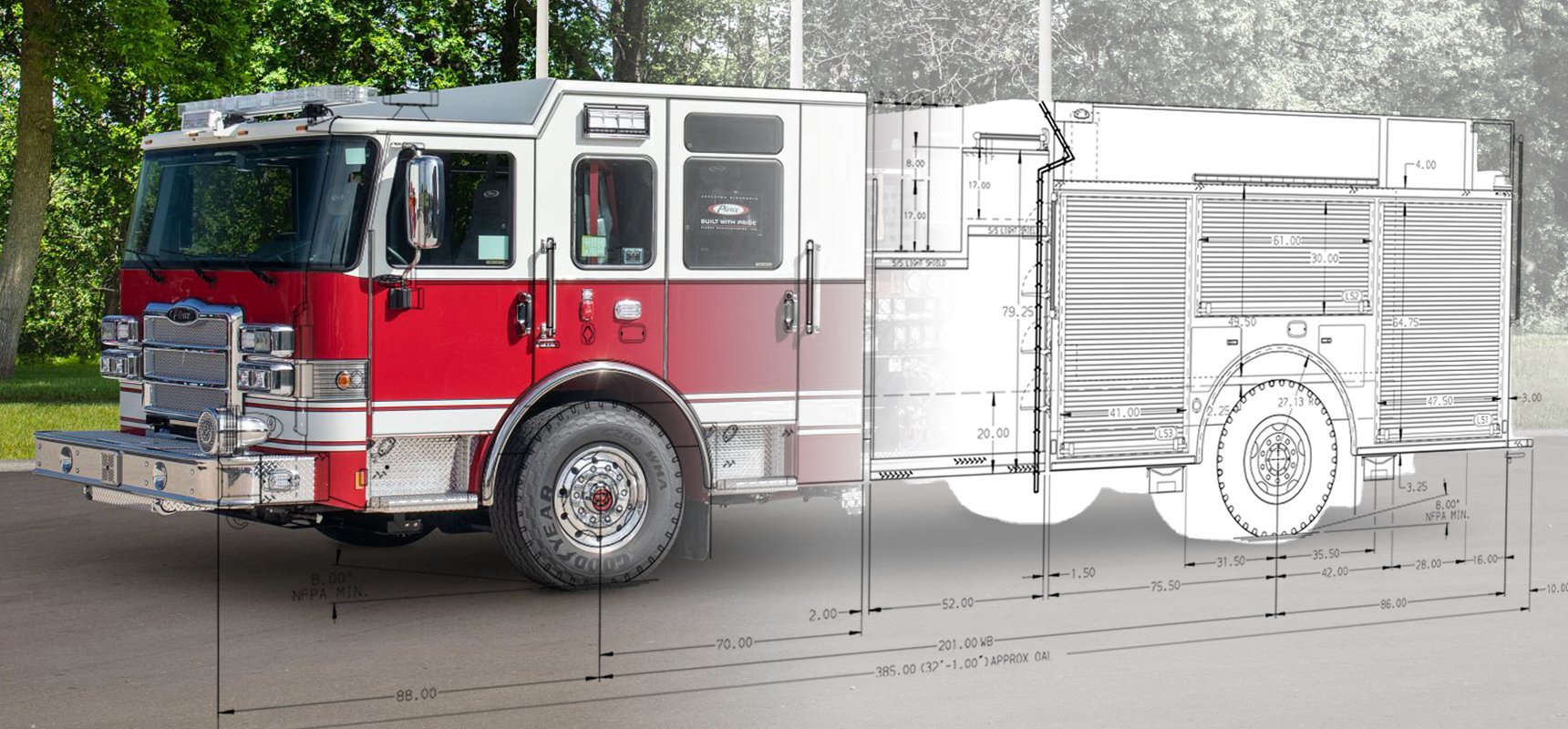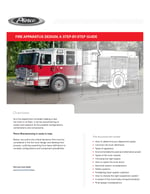Overview
As a fire department considers adding a new fire truck to its fleet, it can be overwhelming to review and research all the possible configurations, combinations and components.
Pierce Manufacturing is ready to help.
Below, we outline the critical decisions that must be considered in the fire truck design and development process, outlining everything from basic definitions to complex configurations and component possibilities.
This page will review:
Understand the Goals Of Your Fire Department
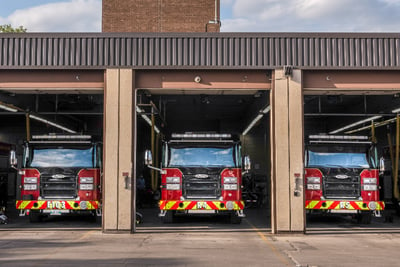
Before doing any research into truck types, configurations and components, it is important to have a clear understanding of the immediate and long-long term goals of the fire department.
- The main mission of the fire truck. Will a new truck be the workhorse of the department, responding to every call, or is it meeting an existing gap in coverage? These considerations can help a fire department determine the best truck type, chassis and components to include in a truck specification.
- Current fleet needs. Whether you are replacing an existing apparatus in your fleet or considering a new type of truck, it’s important to evaluate your current fleet of trucks and determine how a new truck fits into your fleet.
- Service area requirements. Each community has unique needs and the fire trucks that service the community must match these needs. Are there narrow streets or tall structures? Big highway systems or densely populated areas? Rural areas with limited water supply and resources? A fire truck must be designed to match the service areas.
- Geographic terrain. There are many types of fire trucks, each designed to manage specific tasks and, in some cases, specific terrain. Does your service area have flat terrain, or rough, variable terrain? Hills or valleys? Will your vehicle need to go off road? The geographic region can make a big difference in vehicle weight considerations, engine size, horsepower and more.
- Climate. The climate in a region may have an impact on the types of components a fire department plans to use on a new fire truck. In fact, environmental factors may motivate a department to consider specific features, like blacked-out components, e-coat to help prevent deicing agent or salt-water deterioration or more advanced HVAC systems.
How Do You Choose the Right Apparatus and Chassis?
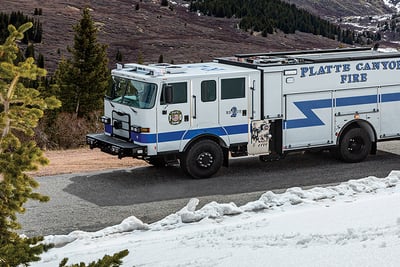
Every detail in the purchase of a fire truck matters. Therefore, understanding the mission of the truck will help your organization make an informed decision.
At Pierce Manufacturing, our team often considers this simple statement—will it fit?
- The needs of your fleet?
- The needs of your community and service area?
- The firefighters?
- The tools that are required for your mission?
- The space you have in your fire station? (height, length and width)
- Your budget?
The type of apparatus your department requires will drive the chassis you choose, which will affect your gross vehicle weight rating, which will, in turn, influence your powertrain and horsepower considerations. Ultimately, this will determine your payload capacity and the equipment and personnel that can be onboard
It's exactly why working with an experienced fire truck manufacturer to walk through the fire truck design process is so helpful.
Balancing your budget as well as all the critical elements and knowing what to look for to match the mission of a fire truck can seem overwhelming without the right guidance and support.
Learn more about the support Pierce can offer before, during and after the purchase of a fire truck.
Common Fire Truck Apparatus Definitions
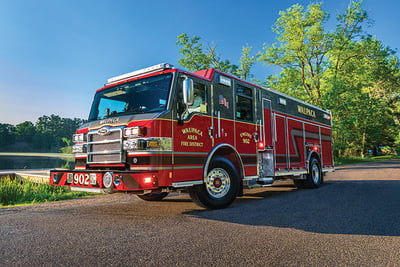 Before a fire truck purchasing committee initiates research, it can be helpful to have a basic understanding of the key terms often used to describe fire trucks in the ordering process. Here is a brief overview.
Before a fire truck purchasing committee initiates research, it can be helpful to have a basic understanding of the key terms often used to describe fire trucks in the ordering process. Here is a brief overview.
NFPA standards for National Fire Protection Association, which delivers information and knowledge through more than 300 consensus codes and standards, research, training, education, outreach and advocacy.
Gross Vehicle Weight Rating (GVWR) is defined by NFPA 1900 as “the final-stage manufacturer’s specified maximum load-carrying capacity of a single vehicle.”
Curb Weight is the total overall weight of a vehicle alone, with no equipment or personnel on board. It is defined by NFPA 1900 as ‘the total weight of the complete vehicle less the payload.”
Payload capacity is the total weight of all of the cargo, personnel and equipment on board a fire apparatus. The payload capacity is calculated by subtracting curb weight from a fire truck’s gross vehicle weight. Payload Capacity = GVWR – Curb Weight.
Gross Axle Weight Rating (GAWR) is defined by NFPA 1900 as “the final stage manufacturer’s specified maximum load-carrying capacity of an axle system, as measured at the tire-ground interfaces.”
Horsepower is the unit of measure for power and is often understood as the rate at which work can be completed.
Drivetrain is the interaction of several parts working together that when combined with the power, thrust a vehicle into motion. The drivetrain usually consists of the transmission, driveshaft, differential, axles and wheels.
Powertrain, on the other hand, can be understood as the elements of the drivetrain combined with the source of propulsion (diesel or electric engine) and the axles to put a vehicle into motion.
Angle of approach is defined by NFPA 1900 as “the smallest angle made between the road surface and a line drawn from the front point of ground contact of the front tire to any projection of the apparatus in front of the front axle.”
Angle of departure is defined by NFPA 1900 as “the smallest angle made between the road surface and a line drawn from the rear point of ground contact of the rear tire to any projection of the apparatus behind the rear axle.”
Tip Load Capacity is used for aerial apparatus and refers to the maximum weight the aerial device can hold at the tip without tipping over the apparatus.
Why do these definitions matter, you may wonder? It is the perfect way to frame up a discussion of the types of available apparatus, chassis and beyond.
Type of Apparatus
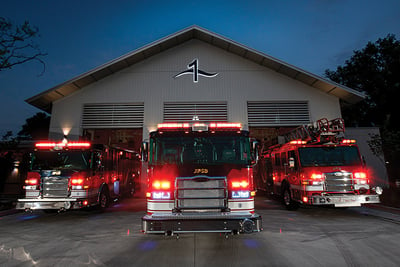 The right type of apparatus is often the subject of early conversations when a new fire truck is being considered.
The right type of apparatus is often the subject of early conversations when a new fire truck is being considered.
Fire trucks can also be classified by type and function according to The NFPA 1900 Standard, Standard for Automotive Fire Apparatus, and the National Wildfire Coordinating Group (NWCG) Standards for Wildland Fire Resource Typing.
To view more about this type of classification and why it exists, read our helpful blog post: Types of Fire Trucks: An Overview and Comparison.
Here is a brief overview of each type of fire truck apparatus:
Pumper Apparatus
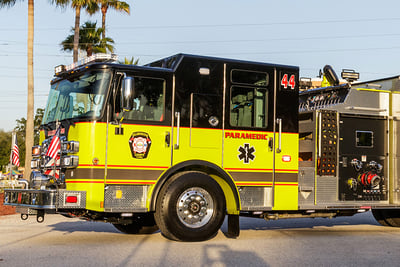 A pumper apparatus, often referred to as a traditional fire engine, is a truck specifically designed to transport and pump water.
A pumper apparatus, often referred to as a traditional fire engine, is a truck specifically designed to transport and pump water.
The National Fire Protection Association (NFPA) states that a pumper is “A fire apparatus with a permanently mounted fire pump of at least 750 gpm (3000 L/min) capacity, 300 gallon water tank, and hose body whose primary purpose is to combat structural and associated fires.”
Regarding equipment storage, NFPA requirements also note that pumpers must have a minimum of 40 cubic feet of enclosed weather-resistant compartmentation.
Pierce Manufacturing has several pumper fire truck configurations available to customers, from heavy-duty rescue pumpers to high-flow industrial pumpers, mini pumpers and more.
Aerial Apparatus
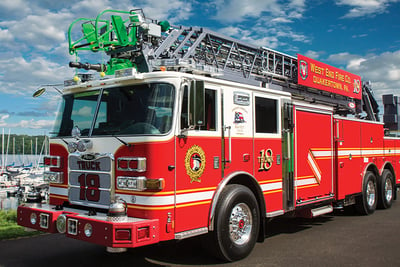 An aerial apparatus is often referred to as a tower, ladder or tiller fire truck and can include a platform as well.
An aerial apparatus is often referred to as a tower, ladder or tiller fire truck and can include a platform as well.
According to NFPA requirements, an aerial apparatus must be equipped with an aerial ladder, elevating platform, or water tower as well as:
- A minimum of 115 ft of ground ladders, including one (1) attic ladder, two (2) straight ladders with folding roof hooks and two (2) extension ladders.
- A minimum of 40 cubic feet of enclosed weather-resistant compartmentation.
In addition, section 8.9.3 outlines an extensive list of minor equipment that must be included on every aerial apparatus before it is put into service, including the number of axes, pike poles, crowbars, SCBAs, wrenches, shovels and more.
Learn more about aerial fire trucks on our informational page here.
Rescue Apparatus
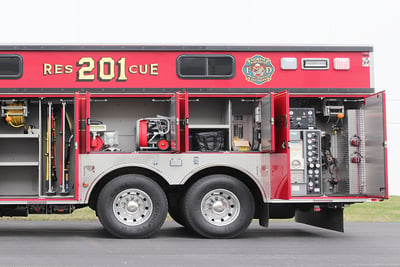 As its name suggests, a rescue fire apparatus is typically outfitted and used for rescue operations.
As its name suggests, a rescue fire apparatus is typically outfitted and used for rescue operations.
Rescue fire trucks are often equipped to match the designed rescue type, be it hazardous material mitigation, urban search and rescue, fire ground support, or water rescue, to name a few.
Rescue fire trucks can be classified further as either a walk-in rescue, where there is enclosed interior space or a non-walk-in rescue, consisting of body compartment storage throughout.
Compare the different types of rescue apparatus here.
Tanker Apparatus
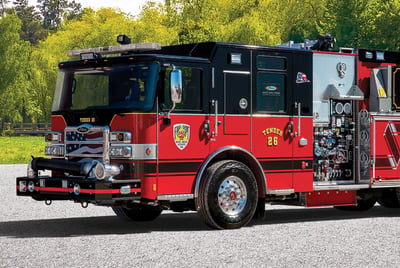 A tanker apparatus or water tender is a specialized apparatus designed specifically to transport water to an emergency.
A tanker apparatus or water tender is a specialized apparatus designed specifically to transport water to an emergency.
According to NFPA standards, a tanker truck must be equipped with a water tank(s) that meets NFPA 1900 Chapter 18 guidelines and provides a minimum water capacity of 1000 gallons. Some of the guidelines of a water tanker include detailed specifications in regard to construction, tank cleanout, tank-to-pump intake, tank-to-pump flow rate, filling and venting and overflow precautions.
Learn more about tanker apparatus now.
Pierce Ultimate Configuration Apparatus (PUC)
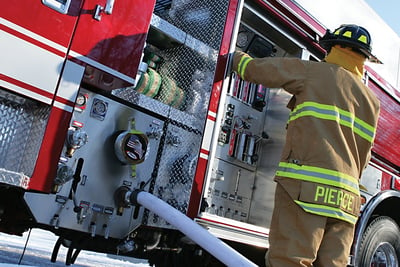 The Pierce Ultimate Configuration (PUC™) water pump is a unique design that minimizes the space required for the pump and pump controls, thereby increasing the maneuverability of the vehicle and improving the maintenance accessibility.
The Pierce Ultimate Configuration (PUC™) water pump is a unique design that minimizes the space required for the pump and pump controls, thereby increasing the maneuverability of the vehicle and improving the maintenance accessibility.
The PUC is available on pumpers, rescue pumpers, tankers and aerials.
Read our blog to learn more: Pierce Ultimate Configuration: 8 Key Benefits for Fire Departments.
Quint Apparatus
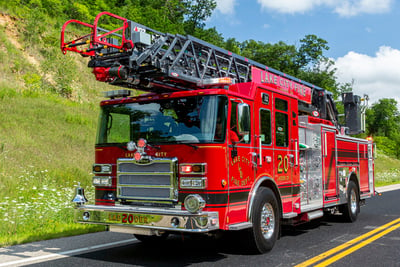 A quint fire truck is an apparatus that combines the equipment of a ladder truck and the water-pumping capabilities of a fire engine. A quint truck features five key elements to carry out firefighting functions:
A quint fire truck is an apparatus that combines the equipment of a ladder truck and the water-pumping capabilities of a fire engine. A quint truck features five key elements to carry out firefighting functions:
- Water tank with a capacity of at least 300 gallons
- Water pump with a capacity of at least 1000 gallons per minute (gpm)
- Aerial device
- Fire hose
- At least 85 feet of ground ladders
A quint fire truck is a multifunctional tool offering the capabilities of a pumper and ladder truck, providing immediate support at the scene of an emergency.
Learn more about quint fire trucks here: Is a Quint Fire Truck Right for Your Department?
Fire Truck Environmentally-Focused and Alternative Power Technology
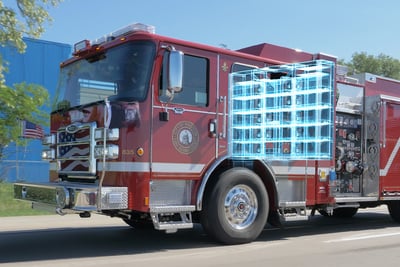 Only recently has the discussion of environmentally-focused technology been a critical factor for fire departments in the fire truck design and purchasing process. As a department considers its short and long-term energy goals, determining whether the inclusion of alternative power technology should be considered is now a big point of discussion.
Only recently has the discussion of environmentally-focused technology been a critical factor for fire departments in the fire truck design and purchasing process. As a department considers its short and long-term energy goals, determining whether the inclusion of alternative power technology should be considered is now a big point of discussion.
Idle Reduction Technology
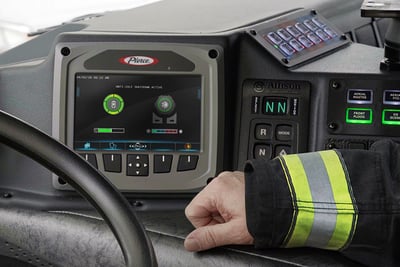 When a vehicle's engine is not being used to move, idle reduction technology steps in to offer environmental and cost-saving benefits. Idle reduction technology can shut off the engine while maintaining consistent power to perform other functions, like the use of accessories and scene lighting. Pierce® Idle Reduction Technology (IRT) pairs automatic diesel engine controls with lithium-ion batteries and lead-acid batteries.
When a vehicle's engine is not being used to move, idle reduction technology steps in to offer environmental and cost-saving benefits. Idle reduction technology can shut off the engine while maintaining consistent power to perform other functions, like the use of accessories and scene lighting. Pierce® Idle Reduction Technology (IRT) pairs automatic diesel engine controls with lithium-ion batteries and lead-acid batteries.
Whether you are interested in zero-emissions, reduced engine maintenance or increased operator safety, idle reduction technology is a valuable system feature to add to your emergency response vehicles. It is available as an option on new apparatus and as an aftermarket solution.
Learn more with this helpful blog: 4 Operational Factors for Fire Truck Idle Reduction Technology
Electric Fire Truck
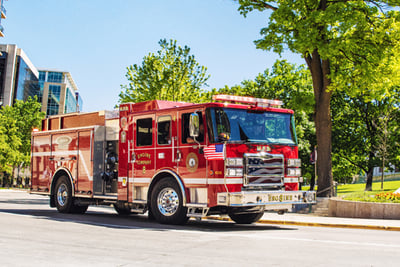 Pierce’s Volterra™ platform of electric vehicles offers a zero-emission vehicle that does not compromise on apparatus features, performance, functionality or safety. Pierce Volterra™ electric vehicles operate under electric power in all normal operational situations but can leverage an internal combustion engine for backup power in extended emergency operations.
Pierce’s Volterra™ platform of electric vehicles offers a zero-emission vehicle that does not compromise on apparatus features, performance, functionality or safety. Pierce Volterra™ electric vehicles operate under electric power in all normal operational situations but can leverage an internal combustion engine for backup power in extended emergency operations.
Learn more about electric vehicle charging infrastructure now.
Types of Chassis
What is a chassis?
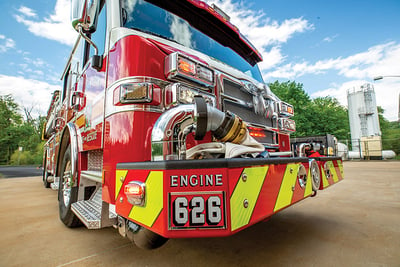
A chassis is the foundation on which a vehicle is built. The chassis consists of a frame and most of the vehicle components such as the engine, transmission, steering system, axle assemblies, wheels and brakes.
How a fire truck chassis is designed affects its power and payload capabilities as well as the vehicle’s ability to function well in certain situations.
Pierce Manufacturing offers several custom and commercial chassis options.
| Enforcer Chassis | The Pierce Enforcer™ chassis ensures reliable performance with powerful engine options, TAK-4® independent suspension and Pierce’s proprietary Command ZoneTM multiplexed electrical system. The Enforcer assures superior maneuverability in tight or difficult circumstances, and the large, wrap-around windshield offers maximum visibility. |
| Impel Chassis | The Pierce Impel® draws from the Velocity® chassis and a wealth of standard features and available options to give customers solid value and fire apparatus specifically outfitted to match local needs. From the wide, roomy cab that carries up to 10 personnel, to the large windshield and daylight windows that provide excellent visibility, to the ergonomic and safety details, the Impel performs to firefighter standards. |
| Saber Chassis | The Saber® is a classic fire truck chassis, Pierce’s proven industry standard, updated to meet the challenges of today’s firefighting. The Saber delivers all-around value, with features that include greater maneuverability, wrap-around visibility, more room for crew members, especially up front, easy-access maintenance and lower steps that make entrance and exit easier and safer. |
| Velocity Chassis | Designed with input from real-life firefighters, the Pierce Velocity® is the essence of functionality, allowing personnel to prepare and perform efficiently. The wide, spacious cab has ample headroom, legroom and floor space to carry up to 10 people comfortably. Also, it can be configured for additional storage or equipment space. Massive steel frame rails ensure superior handling, the panoramic windshield provides maximum visibility, and wide doors make it easy for geared-up personnel to exit quickly and safely. |
Choosing the Right Engine
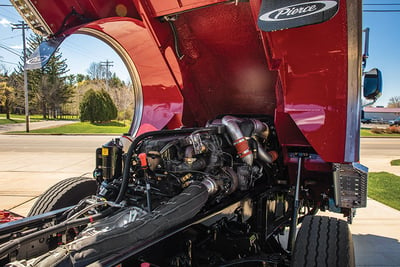 Selecting the right engine for a new apparatus is typically based on the geographic terrain and the power requirements of the fire truck.
Selecting the right engine for a new apparatus is typically based on the geographic terrain and the power requirements of the fire truck.
- Geographic terrain. If your service area includes hills or mountains, an engine with higher horsepower is likely required. Conversely, if your community is flat with no hills, a smaller engine with lower horsepower will likely cover all of your needs.
- Power requirements. A heavy-duty fire truck loaded with equipment or a pumper truck with a large tank often require a more powerful, big block engine. An engine with higher horsepower is required for trucks with higher vehicle weight.
Pierce is proud to carry several engine brands to help each fire department find the right fit for its truck and the community. This includes the PACCAR MX-13 engine, built by PACCAR at its Columbus, Mississippi facility. In 2021, PACCAR granted Pierce exclusive use of the MX-13 engine in the fire truck industry. Learn more about PACCAR’s industry-leading design features now.
Choosing the Right Cab and Cab Doors
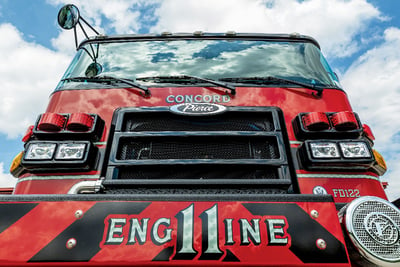 As a fire department works through the various stages of designing a fire truck, the mission of the vehicle remains at the core of every decision.
As a fire department works through the various stages of designing a fire truck, the mission of the vehicle remains at the core of every decision.
This holds true in the discussion of choosing the right cab and cab doors for a new apparatus. The cab choice aligns with the chassis of choice and thus, affects many of the configuration options available.
As your fire department thinks about the cab, there are a few questions to consider:
- What best meets your requirements regarding width, length and height?
- How many personnel will travel on board?
- Does the cab require a temperature-controlled area for pharmaceuticals or other sensitive materials?
- Are you planning to integrate any clean cab initiatives?
Pierce is proud to offer a variety of fire truck cab length, width and height options depending on the model selected, including cab lengths from 57-84 inches, roof styles that include flat or raised, at 10, 16, 20 or 24 inches, and cab widths that can be anywhere from 94 ¾ inches to 100 inches wide. Working with your fire truck manufacturer to understand the needs of your department and the mission of your truck can help determine the right cab choice.
In terms of cab doors, there are two considerations:
- Full height cab doors go all the way down and cover the door stepwell area.
- Barrier doors are designed to be shorter and clear a higher pathway, allowing them to open more easily over highway guardrails and parked cars.
Choosing the right cab door depends on the response area the fire department serves, and the types of obstacles firefighters might encounter on scene. If narrow streets, parked cars or roadway barriers are a concern, barrier doors offer prompt accessibility without fear of damage to the fire truck or nearby property.
Electrical System Selection
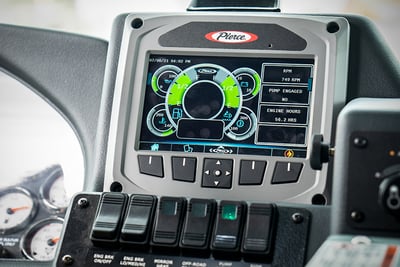 Every modern firefighting apparatus contains elements of electrical systems.
Every modern firefighting apparatus contains elements of electrical systems.
- Hardwired systems are constructed with fuses and relays. This design allows trained fire department personnel to replace fuses and relays on their own. However, with these systems it is often difficult to diagnose issues.
- Multiplex systems use computers and modules to manage inputs and outputs. The programs are simple to run but require training. The ability to diagnose issues and make modifications is fast and efficient.
Utilizing military-grade hardware and wire harnesses, Pierce’s electrical systems provide fire departments with technology built from the ground up with the desired level of interface, diagnostics, prognostics, maintenance, navigation and more.
The ClearSky Intelligence™ web-portal allows users to view, track, diagnose and troubleshoot the system. This expedites service support, allowing firefighters to intervene when critical failures occur to prevent further damage, improving budget forecasting and maintenance planning.
Learn more about Pierce electrical systems now.
Safety Systems
Firefighters and the communities they serve rely on safe and dependable fire trucks. Fire truck safety systems are a critical component in fire truck design and manufacturing to protect the well-being of those tasked with saving lives.
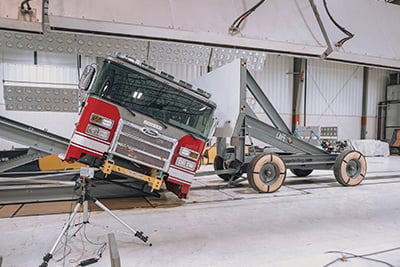 A fire truck chassis can be manufactured to include many safety systems, including:
A fire truck chassis can be manufactured to include many safety systems, including:
- Side roll protection system for occupant protection
- Frontal air bags for occupant protection
- Seat belt warning system ensures occupants are properly buckled and ready reach seat belts to make buckling up one-handed and hassle-free
- Collision avoidance system warns before accidents can occur
- Lateral g-roll indicator alerts driver to excessive chassis roll
- Interior dome lights to enhance nighttime visibility
- Noise insulation and soundproofing provide a quieter interior environment
- Tinted windows reduce solar load
- Electronic Stability Control (ESC) and Roll Stability Control (RSC) auto braking systems
- Tire protection system including tire monitoring and tire blowout band protection
Additionally, fire trucks must be tested against NFPA standards to ensure compliance. Underwriter’s Laboratory (UL) completes all Pierce fire truck testing and ensures that each design detail is safe and effective for operators.
Following industry standards and regulatory body requirements, fire truck crashworthiness is also tested by fire truck manufacturers. Fire truck cab crash testing is a process where fire apparatus are put through various tests, many of which are destructive in nature, to ensure the vehicle meets or exceeds industry standards. Learn more about the process and regulatory ratings and standards now.
Cab integrity is another key aspect to fire truck safety. The Society of Automotive Engineers outlines very specific cab integrity evaluation and safety requirements intended to protect the occupants of the cab. Learn more about these specifications and the different approaches fire truck manufacturers use to pass this standard in this informative blog: Fire Truck Cab Safety: Maintaining Cab Mounts In A Collision Test
Firefighting Foam System Selection
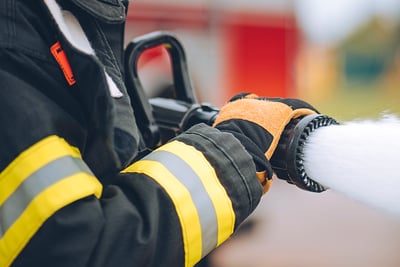 Firefighting foam systems are designed to improve the fire-extinguishing capabilities of water. Foam acts as a blanketing and cooling agent, and it can be produced by adding a foam concentrate to water on the fire truck.
Firefighting foam systems are designed to improve the fire-extinguishing capabilities of water. Foam acts as a blanketing and cooling agent, and it can be produced by adding a foam concentrate to water on the fire truck.
A foam system allows a predetermined amount of foam to be mixed with water through the fire apparatus pump mechanisms. As such, anytime water is used, a foam system can be activated to improve water’s firefighting effectiveness.
There are two types of foam fire departments can select based on the types of calls they face.
- Class ‘A’ foam is used for Class ‘A’ fires, which include solid combustibles such as paper, wood, cloth and some plastics.
- Class ‘B’ foam is used for Class ‘B’ fires, which are fires that involve flammable liquids such as alcohol, ether, oil, gasoline or grease.
Much like any component, part or feature of custom apparatus, determining the right foam system requires a thorough understanding of a fire department's needs, including the following elements.
- How does your fire department intend to use a foam system?
- Determining the use of Class ‘A’ foam, Class ‘B’ foam and the appropriate percentage requirements for each run.
- What is the worst-case scenario?
- Compartment and storage space available.
- How much foam will your fire department use in “X” amount of time?
At Pierce, we collaborate with each department to decide which foam system best fits the apparatus during a typical emergency response. By offering and installing Hercules™ CAFS, Husky 3™, Husky™12 and Husky™ Industrial, Pierce ensures every fire department is equipped and satisfied with the foam system of their choice.
Learn more about foam system options in this helpful blog: Fire-Fighting Foam: What It Is and Why Fire Departments Need It
Choosing the Right Suspension
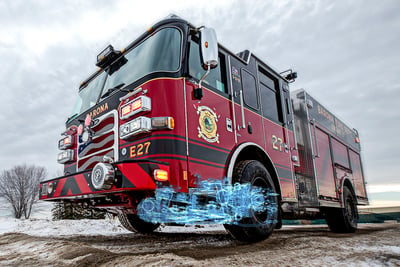 Choosing the right fire truck suspension system requires an understanding of your vehicle's role in the fleet as well as the needs of your fire department and service area. How the fire truck is used, how often it's used, and the environment in which it's used are all important factors to consider.
Choosing the right fire truck suspension system requires an understanding of your vehicle's role in the fleet as well as the needs of your fire department and service area. How the fire truck is used, how often it's used, and the environment in which it's used are all important factors to consider.
Other factors to consider include:
- The terrain in the service area
- Equipment that will be on board the apparatus
- Road layout and physical structures in the area
- The primary mission of the truck
The type of fire truck is also important. For example, a tanker truck will have different suspension system needs than a pumper, aerial, or rescue fire truck.
Below are some of the most common suspension systems in fire trucks:
- Multi or stacked leaf spring
- Parabolic leaf spring
- Walking beam or bogie
- Air ride
- Independent suspension
An independent suspension system allows each wheel on the same axle to move vertically and independently of the other. This type of suspension offers the best quality ride without sacrificing the lateral roll stiffness, making it easier to maneuver around tight corners. Other benefits include greater load-carrying capacity and better traction.
Pierce is proud to offer two independent suspension systems: TAK-4® Independent Front Suspension (IFS) and TAK-4® Independent Rear Suspension (IRS). These patented systems increase ride quality by up to 340-percent, reducing stress on the tires and overall vehicle components.
Other key features and benefits of Pierce’s independent suspension systems include:
- Less wear and tear on equipment
- Reduced maintenance
- Faster braking times
- Higher range of steering and wheel control
- Increased tire life
If a fire department needs extreme mobility, Pierce’s TAK-4 T3™ system combines the benefits of the TAK-4 IRS with a 100-percent mechanical rear steering system. The TAK-4 T3 system allows increased turning radius, increased tire life, and lane-to-lane turning.
Learn more about fire truck suspension systems here: Fire Truck Suspension Comparison Guide
Body Compartmentation
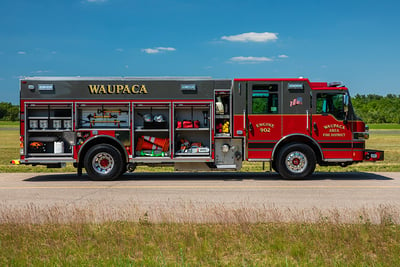 A fire department must work closely with its fire truck manufacturer early in the design process to discuss the function and primary use of the apparatus.
A fire department must work closely with its fire truck manufacturer early in the design process to discuss the function and primary use of the apparatus.
Why? To optimize equipment storage.
The type of equipment and tools, the mission of the truck, the number of firefighters on board and the type of firefighting gear required are all important elements to consider when customizing storage compartments.
Common compartment storage options include:
- Bumper storage
- Body compartment storage
- Mounting brackets
- Pull-out trays
- Tool storage boards
- Hatch compartments
Every fire truck is unique, and Pierce will work with you to help determine which compartment options are right for your fire department’s needs and how to find the right strategic storage configuration to support fast and efficient on-scene response.
Learn more about strategic compartmentation and how to integrate it in your fire truck design here: Fire Truck Storage: Compartment and Storage Systems FAQ
Pierce BMP Program
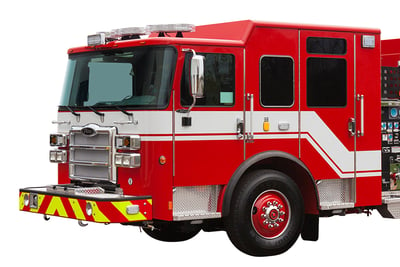 Now that you've had the opportunity to walk through many of the best design practices for building a fire truck, it’s time to put your plan into action.
Now that you've had the opportunity to walk through many of the best design practices for building a fire truck, it’s time to put your plan into action.
Using Pierce's patented Build My Pierce™ (BMP™) program, an interactive custom configurator allows a choice of custom, market-trending options with a wide range of chassis and configurations available.
The BMP configurator does not sacrifice features to improve turnaround time but instead includes more than 1,500 available options and 35 customizable configurations. Pierce has delivered over 425 BMP vehicles to fire stations worldwide. The benefits include:
- Unprecedented 180-day delivery, depending on slot availability.
- Finalize details in the beginning, including a Pierce visit 21 days after booking.
- Completely custom-built and designed Pierce apparatus.
BMP is an excellent option if you are looking for an efficient ordering process and accelerated delivery for apparatus with a higher level of customization options in comparison to stock vehicles.
In ten minutes or less, your fire department can get a fully-engineered, custom truck drawing.
What are you waiting for?
